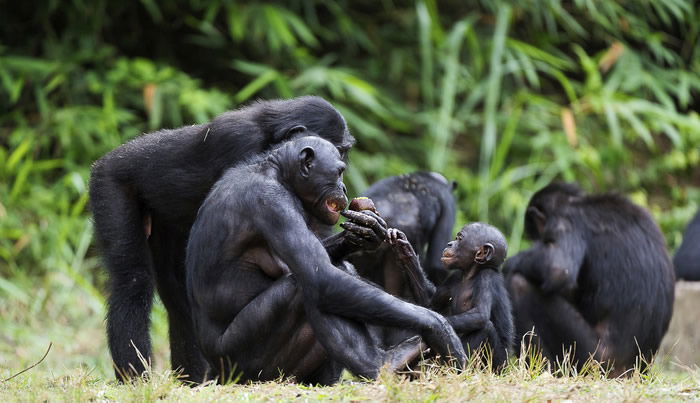
Do Babbling Bonobos Decipher the Evolutionary Secrets of Baby Talk?
News to Know
Abstract
Bonobo peeps said to offer a peek at how humans learned to speak.
News Source
Bonobos—the “hippie chimps”—are widely regarded as the most empathetic of the great apes, veritable models of morality. Now a new study of bonobo peeping noises suggests they communicate with one another like human babies do with their parents. Researchers believe the bonobo’s apparent linguistic sophistication reveals “evolutionary roots that predate the evolution of human speech.”1
Wanted: Animal Models
Long before children utter their first words, they babble sounds caregivers interpret based on context. The same sounds can have different meanings. (This is called functional flexibility.2) Parents carry on conversations with these babbling babies until their babies reward them with real words. Evolutionists claim increasing complexity in the linguistic ability of human infants and toddlers “reveals something about the evolutionary history of language.”3 Believing humans and great apes diverged from a common ancestor, they hope primate animal models will reveal how humanity’s ancestors evolved the ability to speak.
Such animal models are hard to come by, however. Until now, for instance, scientists have thought that only human utterances exhibit functional flexibility. Each sound a primate animal makes seems to reflect a fixed meaning or emotion. Primatologist Zanna Clay and colleagues challenge that idea and believe their observations have evolutionary significance. Clay says, “It appears that the more we look, the more similarity we find between animals and humans.”4
Bonobos make a high-pitched peeping sound with their mouths closed. This sound does not resemble human baby talk, but Clay’s team asserts that bonobos peep in a way analogous to the way a baby uses its repertoire of sounds, in which each sound’s meaning is contextually determined. “When I studied the bonobos in their native setting in Congo, “ Clay explains, “I was struck by how frequent their peeps were, and how many different contexts they produce them in. It became apparent that because we couldn't always differentiate between peeps, we needed [to] understand the context to get to the root of their communication.”5

Are these bonobos sharing the secrets of the origin of human language? USO/iStock/Thinkstock.
Context Is Key
To decipher the possible meanings of bonobo vocalizations, Clay’s team observed 39 wild bonobos of various ages in a bonobo community. They recorded peeps and catalogued what the bonobos were doing and what was going on around them during each peep. They classified the circumstances surrounding the peeps to establish context. After all, among humans, context is key to effective communication from the cradle to the conference room.
The discovery of a yummy food is an example of a positive context. Traveling, resting, and grooming are classified as neutral contexts. The sight of a predator is a negative context. Alarm peeps vary greatly but are generally of higher frequency and shorter duration. However, acoustical analysis confirms peeps in positive and neutral contexts are fairly uniform and indistinguishable. Each animal has its own distinct voice, but each uses the same basic sound whether excited about a snack, responding to another bonobo’s peeps, or just passing the time.
The Bonobo Whisperer
Clay’s team believes peeping bonobos are trying to share information with others. Fellow bonobos must then interpret the peeps according to context. Though they admit more research is needed, they explain, “Peeps could be reliably discriminated on the basis of caller identity across contexts, suggesting that the calls reliably convey other relevant information to receivers.”6 In other words, because each ape has its own recognizable voice it is presumably telling something significant to other apes. Having thus decided that functional flexibility is not uniquely human, Clay’s team believes that further analysis of bonobo vocalization may reveal how human speech evolved.
Bonobos do not continuously chat like furry people sharing their deepest thoughts. “While much of bonobo vocal behaviour is functionally fixed by nature, such as screaming during agonistic encounters, barking during alarm and laughing during play,” the authors observe, “their most common vocalisation, the ‘peep’ is also produced in highly flexible ways across a wide range of contexts.”7 Clay’s team believes peeping is a sort of evolutionary transitional form for language. “We interpret this evidence as an example of an evolutionary early transition away from fixed vocal signalling towards functional flexibility,” they explain, adding, “While functional flexibility is undoubtedly more developed in human speech, results from the current study contribute to the debate surrounding speech evolution by high-lighting evidence for a possible intermediate stage in the communicative repertoire of our closest living relative, the bonobo.”
Conclusions at a Stretch
The acoustical analysis Clay’s team performed on their recordings, correlating the characteristics of peeps with the circumstances in which they were produced, constitutes a sound bit of observational science. Yet the observers cannot know that the apes intended to convey relevant information. Their assertion that bonobo vocalizations exhibit functional flexibility may be a bit premature. The authors even admit, “As always, it is somewhat problematic to draw firm conclusions from negative evidence, that is, the fact that we found no acoustic differences across [positive and neutral] contexts. For example, it is possible that there was subtle variation in other acoustic parameters that we did not analyse, such as amplitude modulation. . . . More conclusive evidence would require carefully designed playback experiments to test whether bonobos have more difficulties discriminating positive and neutral peeps, compared to negative peeps.”8
Maybe bonobos just enjoy peeping. Maybe the sounds of their own voices give them pleasure: the same can be said of many people, but that possibility has no evolutionary significance. Maybe they really are trying convey information or get the attention of their neighbors. After all, bonobos make raspberry noises to get attention; why not peeps too? Yet if (and probably when) additional tests reveal bonobos actually are communicating with one another using peeps, the authors’ evolutionary leaps will still be groundless. God has filled this world with organisms that act in meaningful ways to accomplish the purposes for which He designed them. And God has equipped many sorts of animals with the capacity to communicate with each other and with humans using sounds and gestures. Just ask any dog owner! But does your dog understand you because you supposedly share an ancestral bond? Not at all. Or is it more likely because you have taught your dog to understand a lot of your speech and gestures just as apes can be taught a great deal about human intentions?
Dogs catch yawns from people, and apes from other apes, and some scientists actually claim these behaviors reveal how morality could have evolved, but they do so on the presumption that our origins lie in molecules-to-man evolution rather than in our Creator God’s hands.
Bonobos and chimps also laugh, but they can’t explain what’s funny. Animals cannot explain what they are “thinking.” Indeed, a great deal of bias goes into our personification of animal motives, especially with animals for which we feel a bond, be it as a beloved companion or as a perceived “evolutionary soul-mate.”
Far-Reaching Interpretations
Common designs can be very useful in understanding the nature of development, both normal and pathological. (See, for instance, “Melodious Mice with Clues to Human Language Disorders.”) However, like other anatomical and behavioral similarities between humans and animals, commonalities—even if they exist—between baby talk and bonobo peeps only “support” Darwinian evolution if the observer already presupposes we are evolutionary products. These authors assume that humans and bonobos share an ape-like ancestor. On the basis of that unverifiable worldview-based presupposition, they claim bonobo behavior not only offers insight into the human psyche but also mirrors a stepwise linguistic progression in human evolutionary history.
Clay’s team, in interpreting their observations, draws two sorts of conclusions. Some interpretations reach into the unknowable bonobo’s “mind” while others hark back through unobservable time across supposed millions of years. Conclusions concerning bonobo communiqués may or may not gain support through further observations of bonobo reactions to the peeps of others, though even then ascribing motive to a non-human utterance remains subject to substantial observer bias (aka wishful thinking). However, those conclusions that presume to reach back over millions of years of supposed human evolutionary history have not been and cannot be subjected to scientific testing. In fact, they fly in the face of observable science, biological science that fails to support with any testable observations the claim that man and apes diverged from a common ancestor. (Read more about this issue in “Two Kinds of Science?,” “Did Humans Really Evolve from Apelike Creatures?,” and “Easy-Going Ape Joins Genome Club.”)
Language Right from the Start9
Did the ancestors of modern humans have to evolve the ability to speak, or were the first humans equipped with language right from the start? Extinct varieties of humans, without leaving a written record of their thoughts, cannot now utter a few words to convince us that their brains and genomes equipped them for language production. And while language leaves no fossil record, some scientists maintain that the apparent handedness of Neanderthals attests to their linguistic ability. Furthermore, genetic analysis of the Neanderthal genome has shown that the form of the FOXp2 gene strongly associated with language learning in modern humans matches the Neanderthal gene.10 (Read more about these issues in “FOXP2 and the Non-Evolution of Human Language,” “Handedness of Early Humans Speaks Volumes,” “Does Hugh Ross Believe in Soulless Ancient Humans?,” and “Red-Haired, Fast-Talking Neanderthals.”)
The notion that the predecessors of modern humans, be they our supposed ape-like ancestors or varieties of humans like Neanderthals, had to evolve the ability to create and use language is itself a worldview-based claim that ignores the witness of biblical history, history that is affirmed by scientific observations. If we want to know how human language truly came to be in the unobservable past, we cannot determine it from observing non-human primates in the present. Instead, we should look to a reliable historical record, one provided by a trustworthy eyewitness, our Creator God.
Apes and humans do not share an ancestor, and human linguistic ability was created with man and did not have to evolve. God tells us in His Word that He made man and woman the same day as all kinds of land animals. That was about 6,000 years ago. And only humans were made in the image of God. According to Genesis, Adam and Eve spoke with each other and with God, so we know that God created them with linguistic ability. Linguistic diversity developed as a result of the dispersion from the Tower of Babel. While languages certainly change over time, the linguistic ability God gave to Adam and Eve and the initial multiplication of languages at the Tower of Babel resulted from God’s activity.
Man did not have to evolve the ability to speak and understand words. God created humans with language from the start and began communicating with them immediately. For example, in Genesis 2:19–20 we learn that God brought animals to Adam to see what he would name them. Even after man rebelled against God, God continued to convey His love to us, finally sending His Son, the Word made flesh (John 1:14), Jesus Christ: “But God demonstrates His own love toward us, in that while we were still sinners, Christ died for us” (Romans 5:8). The truth of God’s Word continues to speak of God’s love in every language, straight from God’s heart. Yet the multiplicity of languages offers a tremendous challenge to missionary efforts to spread the gospel. More than 600 million people have no access to God’s written Word in their own language, and many languages today remain without a written form. Many people buy into fairy tales about the evolutionary origin of man, often without much thought about how those falsehoods undermine the faith of many. As Bible-believing Christians, our focus needs to be on spreading the truth of God’s love in every language and providing people with the written Word of God, encouraging them to trust it from the very first verse.
Learn more about God’s design for human language in a series of articles by Dr. John Oller, Jr.,11 an expert in the field of language acquisition and communication disorders (especially autism), in “More Than PIE,” “Language Acquisition: Making Sense of the World,” and “Words Are Us.”
Further Reading
- Do Even-tempered Empathetic Bonobos Reflect Human Evolutionary History?
- Human Evolution
- Animal Behavior
- Primates
- DNA Similarities
- Human Origins
- What Makes Us Human?
- Ape-Man
- Empathy Study and Evolution
- Are Bad Words Inherently Evil?
For More Information: Get Answers
Remember, if you see a news story that might merit some attention, let us know about it! (Note: if the story originates from the Associated Press, FOX News, MSNBC, the New York Times, or another major national media outlet, we will most likely have already heard about it.) And thanks to all of our readers who have submitted great news tips to us. If you didn’t catch all the latest News to Know, why not take a look to see what you’ve missed?
(Please note that links will take you directly to the source. Answers in Genesis is not responsible for content on the websites to which we refer. For more information, please see our Privacy Policy.)
Footnotes
- Zanna Clay, Jahmaira Archbold, and Klaus Zuberbühler, “Functional Flexibility in Wild Bonobo Vocal Behavior,” PeerJ 3, no. e1124 (2015), doi: 10.7717/peerj.1124.
- This term was coined by Dr. D. Kimbrough Oller. It appears in Oller et al., “Functional Flexibility of Infant Vocalization and the Emergence of Language,” Proceedings of the National Academy of Sciences, 110, no.16 (2013): 6318–6323, http://doi.org/10.1073/pnas.1300337110.
- Clay et al., “Functional Flexibility in Wild Bonobo . . . ” doi: 10.7717/peerj.1124.
- Eli Watkins, “Study: Bonobos Talk Like Babies,” CNN, August 4, 2015, http://www.cnn.com/2015/08/04/world/bonobo-baby-study/.
- Ibid.
- Clay et al., “Functional Flexibility in Wild Bonobo . . . ” doi: 10.7717/peerj.1124.
- Ibid.
- Ibid.
- This subheading is adapted very loosely from the song “Love in Any Language” written by Jon Mark Mohr and John Phillip Mays and recorded by Sandy Patty for the Sutton Hill Music and Birdwing Music labels. The refrain’s lyrics are “Love in any language, straight from the heart/Pulls us all together, never apart/And once we learn to speak it, all the world will hear/Love in any language, fluently spoken here.” From http://www.metrolyrics.com/love-in-any-language-lyrics-sandi-patty.html.
- S.E. Fisher and C. Scharff, “FOXP2 as a Molecular Window into Speech and Language,” Trends in Genetics 25, no. 4 (online March 21, 2009): 166–177, doi:10.1016/j.tig.2009.03.002.
- Dr. John W. Oller, Jr., with a PhD in general linguistics, is an endowed professor in the department of communicative disorders, University of Louisiana at Lafayette. His recent publications include Milestones: Normal Speech and Language Development Across the Life Span, Cases: Introducing Communication Disorders Across the Life Span, Autism: The Diagnosis, Treatment & Etiology of the Undeniable Epidemic, and works on biological sign systems, e.g., see “Biosemiotic Entropy: Concluding the Series,” Entropy 16 (2014): 4060–4087, http://www.mdpi.com/1099-4300/16/7/4060.
Recommended Resources

Answers in Genesis is an apologetics ministry, dedicated to helping Christians defend their faith and proclaim the good news of Jesus Christ.
- Customer Service 800.778.3390
- Available Monday–Friday | 9 AM–5 PM ET
- © 2026 Answers in Genesis


